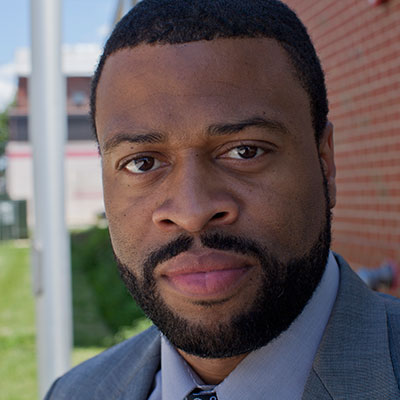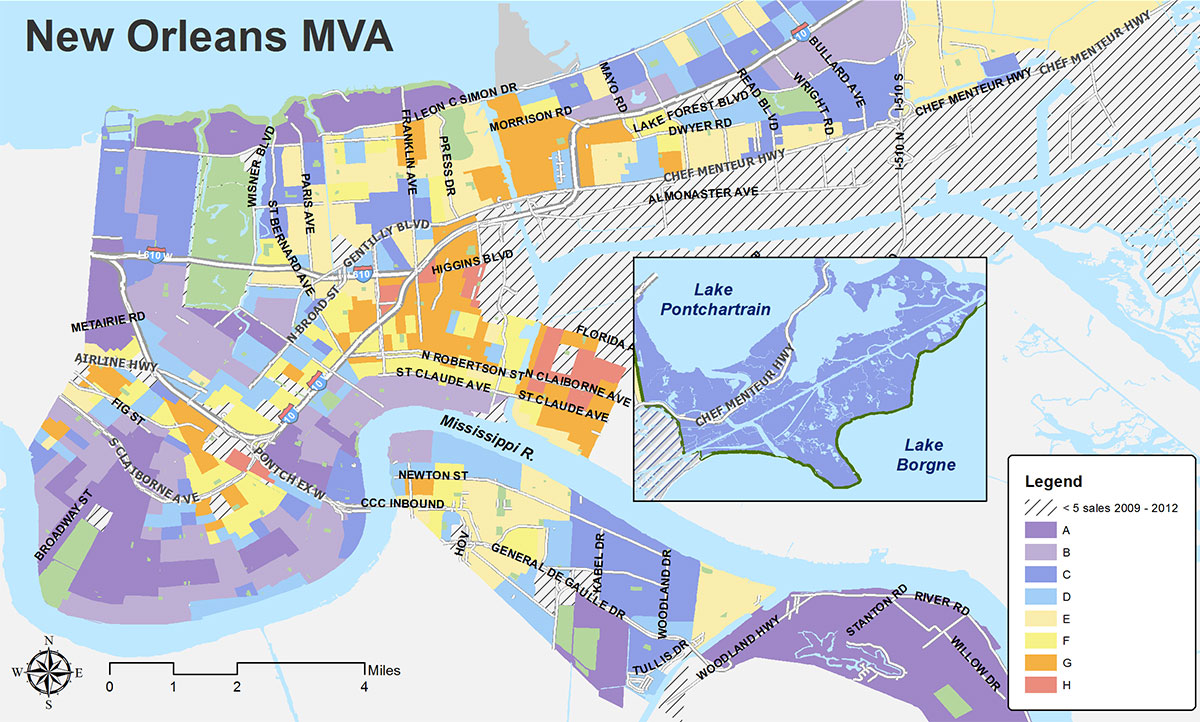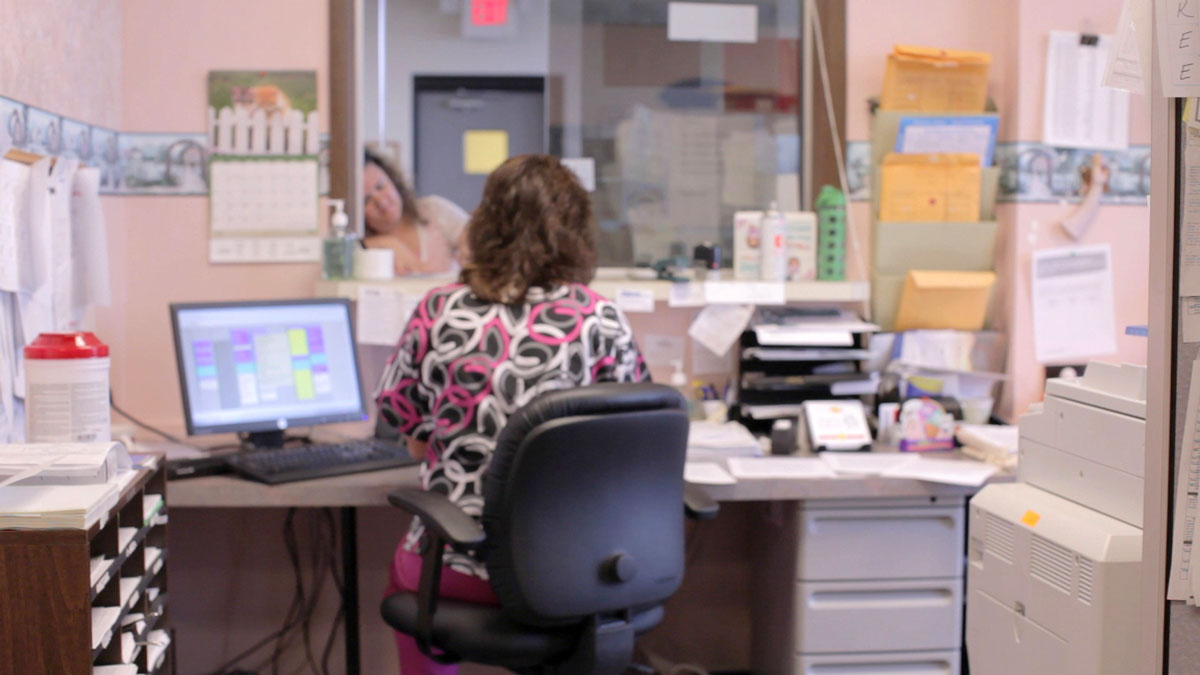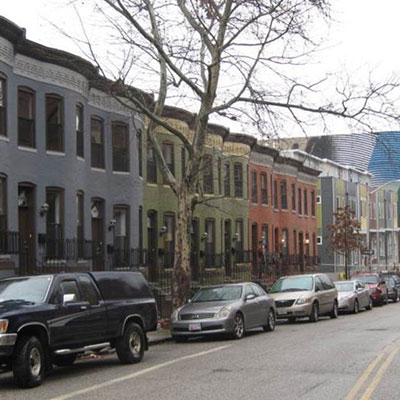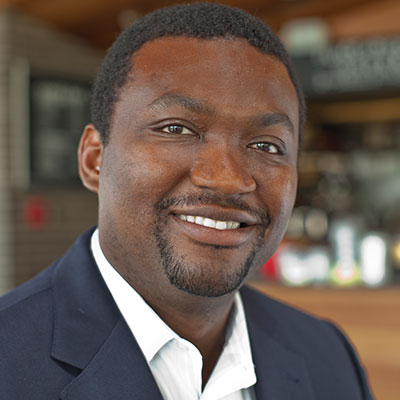 John S. Summers, Chairman of the Board (left)
John S. Summers, Chairman of the Board (left)Don Hinkle-Brown, President and CEO (right)
In the five years since the Great Recession, the United States has suffered enormous economic hardship, particularly affecting low-wealth families. Nationally, the unemployment rate peaked at 10.4% in early 2010 with the labor force participation rate continuing to shrink, reaching 63.2% by early 2013. By late 2009, the number of seriously delinquent home mortgages had risen to 9.7% and even now remains well above pre-recession levels. The poverty rate is at a 20-year high and the Supplemental Nutrition Assistance Program participation has risen 65% since 2008. As our nation has struggled to address the crisis, TRF has risen to the challenge and remained a thriving source of support.
During this period, TRF’s Lending originated $418 million to build and preserve over 2,400 affordable homes, 10,700 charter school seats and 55 food access projects; TRF Development Partners developed over 500 homes; and TRF’s Policy Solutions and Policy Map increasingly served as practical and insightful sources of data and studies.
It has been an extraordinary time for TRF as it has distinguished itself as among the nation’s financial and thought leaders.
In this context, this past year has been one of action and reflection for TRF. Lending, building and analyzing while also digging deeper to better understand how the work we do has a positive impact on people’s lives.
We are implementing our strategic plan and measuring our impact by the number of people we’ve served; neighborhoods we’ve enhanced; and policies we’ve helped to improve. To provide you with deeper insight into TRF’s work and impact, this year’s Report highlights the people and places our work and your investments touch.
We’ve been thinking about what it really means to put capital at the point of impact.
We believe that if we have a greater understanding of how people’s lives are enhanced or changed for the better, and for the long-term, we can become even better problem-solvers. And we can tell you more specifically about how communities get stronger because of your investment.
So, this year’s Annual Report introduces to you the stories of the people and places we’ve affected. People like Brandon Primeaux, who tells us that the soon-to-open supermarket in his town, Chester, represents so much more than better food options and access. And 15-year-old Samantha Romero who tells us she’s on her way to be an astrophysicist in part because of what she’s accomplished in the new chemistry lab in her school. This Report format allows us to tell you twelve stories about twelve ways your investment has helped to improve lives. It allows us to couple these stories with the financials that show how we steward your investments and leverage our collective impact even further.
As always, we are grateful for your trust and commitment to our mission. We value our partnership with you because it drives the kind of social change that has a true impact on people’s lives. As you read this Annual Report, we hope you’ll often visit our new web site that now tells even more human stories about your dollars at work. True stories of your capital delivered to the point of impact.
 John S. Summers, Chairman of the Board (left)
John S. Summers, Chairman of the Board (left)Don Hinkle-Brown, President and CEO (right)
- 1400 Spring Garden
- Camden Lutheran Housing
- Coopers Hill Townhomes *
- Lansing Group
- North 25 Housing Corporation
- NRLP I
- NRLP III
- Oasis Housing
- Paseo Verde Investment Fund *
- Remington Row Too
- Sansom Street Development
- Westminster Apts. *
- Acelero
- Beloved Community Charter School
- Bushwick Ascend Charter School *
- City Invincible Charter School
- Community Health Care
- Henderson-Hopkins School *
- E.L. Haynes Public Charter School
- Esperanza College, a program of
Nueva Esperanza * - Freire Charter School *
- Hope Academy Charter School
- Lady Liberty Academy Charter
School - Newark Community Health Center
- PHN Charitable Foundation
- Primary Health Network —
Punxsutawney *
- 40th Street Live
- Ambler Boiler House *
- Apples and Oranges Fresh Market
- Bottino Holdings, Inc. —
Vineland Shoprite * - Chesapeake Gardens, LLC
- The Chesapeake
- Coppin Heights Healthcare Facility
- CreekSide Co-Op *
- Fair Food Inc.
- LMT Greenhouse / Brightfarms
- MICA Studio Center *
- Parkway Hotel *
- Philabundance — Fare and Square *
- Rector Street Associates
- Save-A-Lot — JR Markets
- Save-A-Lot — Edison Square *
- Seabra Foods *
In 2012, we were awarded our 5th allocation of New Markets Tax Credits of $42 million increasing our allocation to $320 million. Capital under management totaled $672 million at December 31, 2012 as compared to $682 million at December 31, 2011, a decrease of $10 million. Significant activity in 2012 include: the expected maturity and subsequent unwind of two NMTC partnerships; distributions to our private equity investors as we wind down our portfolio investments; repayment of higher cost debt at maturity; and planned non-renewal or reduction of other credit facilities partially offset by receipt of our $42 million NMTC allocation.

Loans and leases outstanding totaled $180.5 million at December 31, 2012 an increase of $21.7 million over prior year. The increase is due to new loan closings of $130.2 million (including NMTC loans) partially offset by loan repayments and net charge-offs. Net charge-offs totaled $850 thousand, or .47% of total loans and leases outstanding, lower than the average for U.S. banks. 96% of TRF’s charge-offs were offset by dedicated grants restricted for such purposes.

Total consolidated net assets increased $8 million to $122 million. Significant activity impacting net assets included an operating surplus of $4.1 million, several grants in support of our food access financing (CDFI Fund $3 million, Robert Wood Johnson Foundation $2 million, and JP Morgan Chase $1 million) and grants in support of our real estate development in Jersey City (Honeywell $2.5 million). In 2012, TRF also received continued support for financing activities from the CDFI Fund of $1.5 million. Accounting disclosures require the inclusion of non-controlling interests in consolidated subsidiaries as part of unrestricted net assets.

Each of TRF’s four business lines provided positive operating contribution margins. The following are the revenue trends.

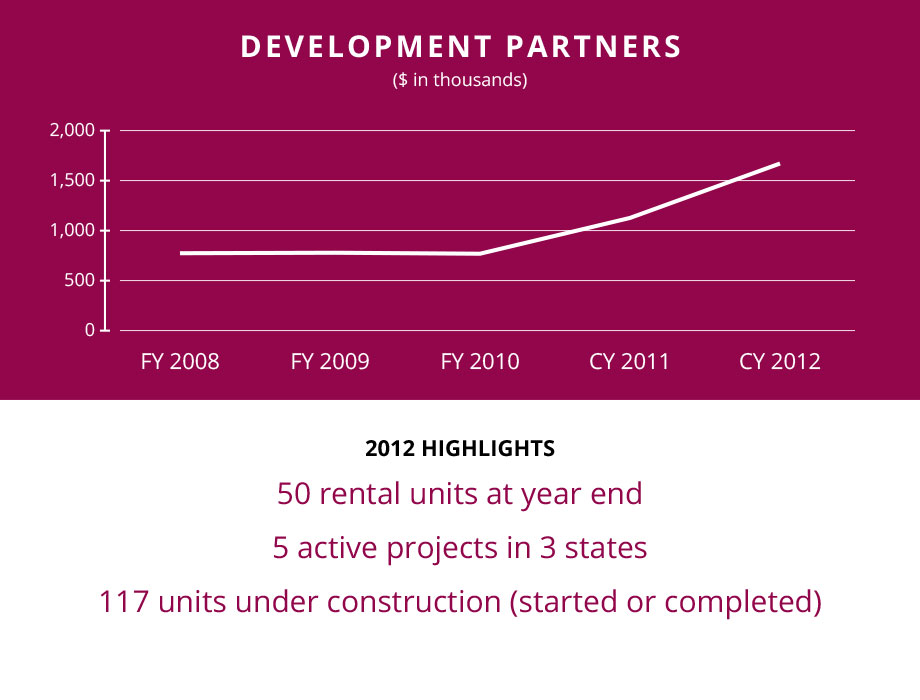

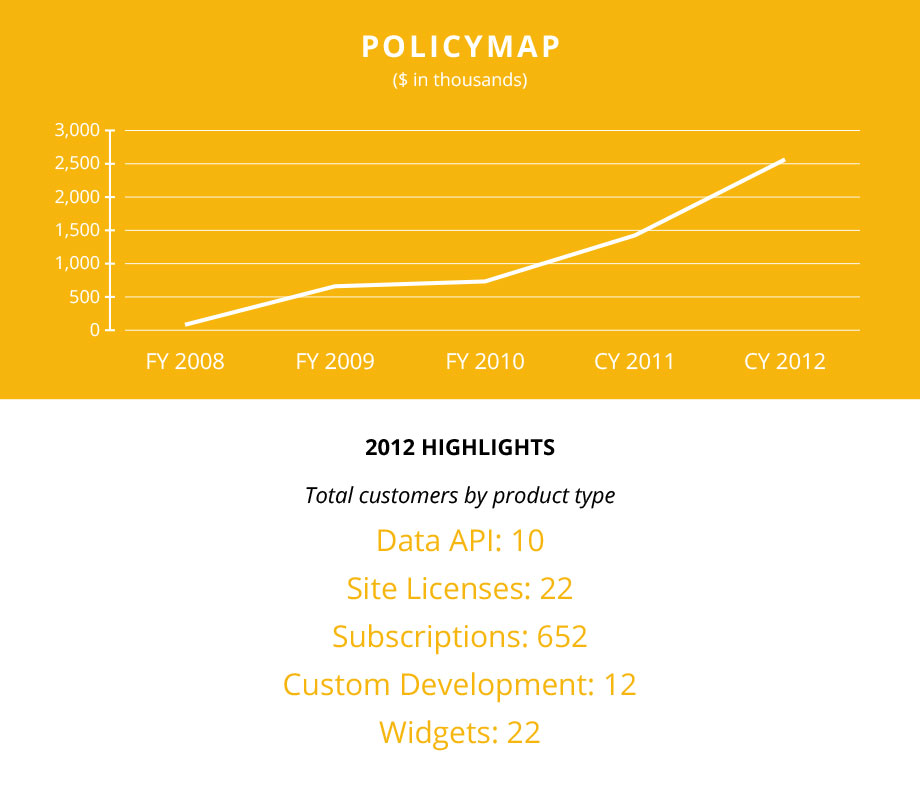
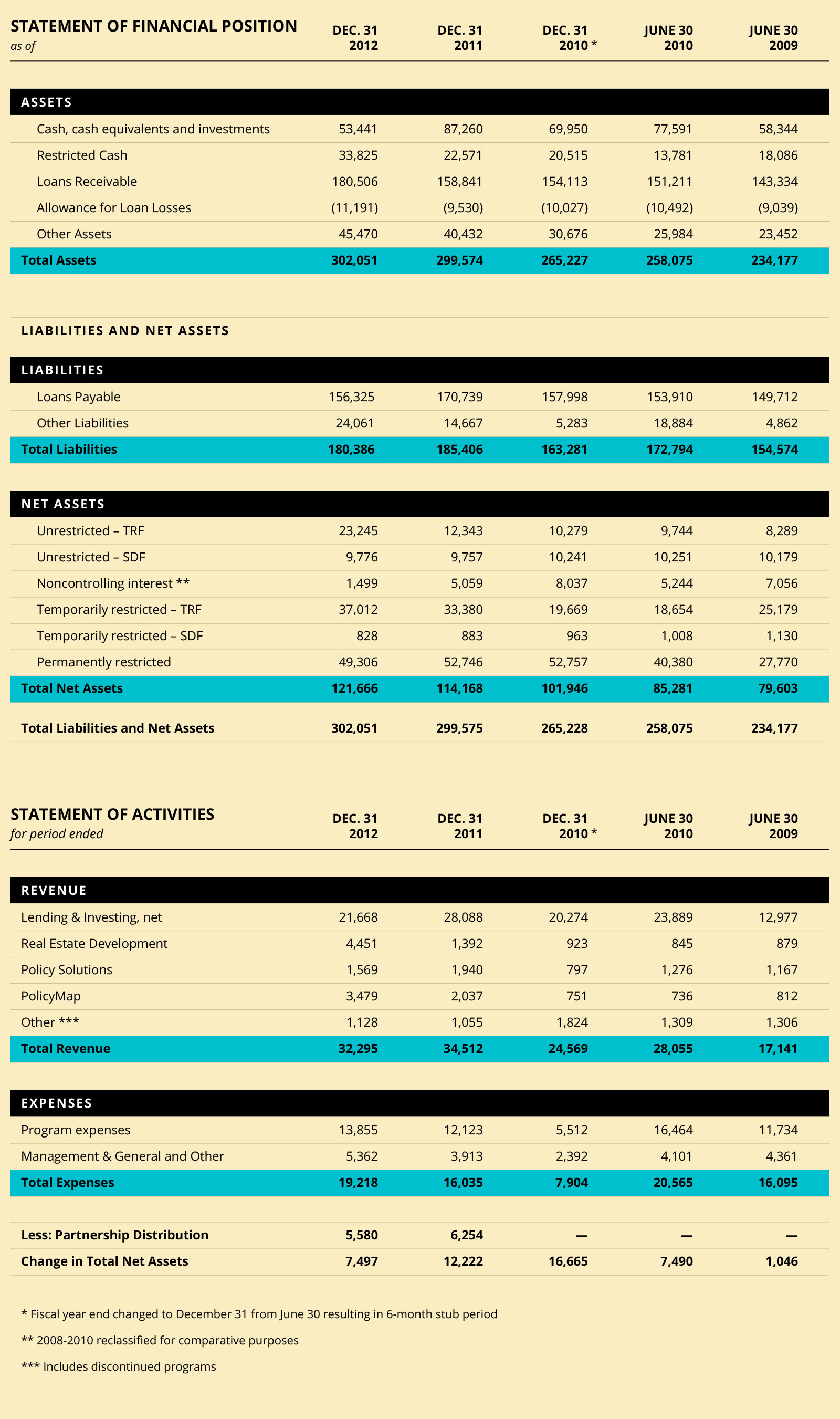
- Adina Abramowitz
- Carolyn T. Adams
- Lucetta Sharp Alderfer
- Ruth Nelson Allen
- Andrea R. Allon
- Suzanne Anastasi Aloi
- Linda S. Altman
- Marynell Anderson
- Marcia L. Angerman
- Elizabeth Daniels Anton
- Johanna M. Berrigan and
Mary Beth Appel - Robert L. Archie, Jr.
- Ina Elfant Asher
- Peter Askey
- John and Ellen Asma
- Denis N. and Judith N. Asselin
- Burt Atherton
- Elizabeth Augustine
- Constance Autumn
- Warren W. Ayres
- Daniel E. and Marcy K. Bacine
- John K. Ball
- James R. Banks
- Regina Bannon
- Richard S. Barkley
- Natalie K. Barndt
- Sharon Barr
- David W. and Pearl Bartelt
- The Rt. Rev. Allen L. and
Jerriette K. Bartlett - Paula Barvin
- Ruth Batts
- Todd, Ariella & Mira Baylson
- Paul W. Beach, Jr.
- Cathy J. and Saul A. Behar
- Joan H. Behr
- H. Gerald Nanos and Laura E. Beider
- Gordon C. and Ruth P. Bennett
- Ruth S. Bennett *
- Charles J. and Mary Ann C. Bentz
- Daniel and Carolyn Berger
- Lawrence H. Berger
- Paul and Joan Bergsteinsson
- Toni Seidl and Richard L. Berkman
- Fred Beste
- Jane Robin Bilger
- Howard Bilofsky
- Allen D. Black
- Bart Blatsein
- Elayne Blender
- Amy E. Farrell and John D. Bloom
- Cheryl and Elson O. Blunt
- Alden and Linda Blyth
- James F. Bodine
- Stuart E. Bogom
- Lila Booth
- Edith F. Borie
- Peter Borie *
- David L. and Marjorie C. Bowler
- David Thomas Bradley
- Jacob B. Bradley
- Margaret Berger Bradley
- Noah B. Bradley
- Joseph M. and Mary Ellen Bradley
- Sallie Carpenter Brooke
- Norma B. Brooks and Joshua Brooks
- Robert Brooks
- William R. and Nancy Brosius
- Robert J. and Judith G. Bruce
- Benjamin David Burenstein
- David H. and Geraldine F. Burton
- Juliana Bussiere
- Daniel B. Butler
- Mary M. Butler
- Peter L. Buttenweiser
- Stacey L. Butterfield
- Miriam Byron
- Leonard A. Caldwell
- Catherine M. Califano
- James and Barbara Calkins
- Mark F. Campbell and Lileng Tan
- Geoffrey E. Campen
- Pearl M. Carpel
- Charles A. Carter, III
- Howard M. Casper
- Lee A. Casper
- Edward F. and Joan H. Cassidy
- Carla C. Castillo
- Susan Catherwood
- John T. Cavanaugh II
- Kevin J. Cavanaugh
- Peter J. Cavanaugh
- Kay A. Cavis and Laurie A. Cavis
- Harry E. Cerino
- Stephen P. Chawaga and Laura Novo
- Jean-Marc Choukroun
- Sandra J. Choukroun
- Jolley Bruce Christman
- Carroll H. and Joseph V.F. Clay III
- C. Sean Closkey
- Helen J. Closkey
- John M. Closkey
- M. Pilar Closkey
- Robert Hogan Closkey
- Isaac H. and Barbara M. Clothier IV
- Wendy S. Buckwalter Coffman
- Thomas and Michele Coghlan
- Angela H. Coghlan
- Benjamin Cohen
- Burton and Linda Cohen
- David Cohen
- Fred Cohen
- Jano Lynn Cohen
- Milton Cohen
- Alan J. and Darlene L. Cohn
- Stephen L. and Ivy L. Cohn
- John L. Colborn
- Ann Frances Cook
- Rebekah Beth Cook-Mack
- Robert L. and Michelle H. Cooney, Jr.
- Randall Copeland
- Betsy S. Corkran
- Matthew T. and Elizabeth Corso
- Robert Coughlin
- Isabel P. Cox-Johnson
- Joseph A. and Joann C. Cozza
- Andrew J. Crist
- Michael A. Crist
- Michael M. Crist
- Paula S. Crist
- Lea M. Csala
- Richard A. D’Amico
- Ralph Cook and Mary Daniel
- Joann Rosen and Ronald Daniels
- Frank F. and Ann G. Davidoff
- Betty Davis
- Nancy Davis
- Ellen Deacon
- Carrie L. DeBehake
- Fred T. Dedrick
- Linda DeJure
- Jeffrey Dekro
- Jose Alfredo and Ingrid F. Dela-Pena
- Peter J. and Beth W. Denitz
- Eleanor Denoun
- Dana Devon
- Jonathan H. Dickstein
- Barbara Dinsmore
- Francis C. Dinsmore
- Ray Diver
- George Dixon
- William Dobkowski
- Elaine G. Dushoff
- Peter J. and Jennifer D. Duskey
- Aaron R. Eisenstat
- Ben N. Eisenstat
- Noel E. Eisenstat
- Edward and Elizabeth Ellers
- Paul S. and Mary Lynn H. Ellis
- James S. and Wendy M. Emrich
- Roger Payne Enloe *
- Jane Erickson
- Ollie M. Ervin
- William H. and Anne Constant Ewing
- Michael and Helen Feinberg
- Rabbi Jennifer E. Feldman
- Janet L. Filante
- Stefanie K. Fine
- Marcia M. Finisdore
- Dina Fink
- Graham Finney
- Mrs. Graham Finney
- Jeanne B. Fisher
- John Fisher
- Peter E. and Margaret W. Fleming
- Mrs. Phyllys B. Fleming
- James T. Fleming
- Otto Sam Folin
- Diane Freaney
- Joseph Freedman
- Dayle Friedman
- Elizabeth Fry
- Robert E. Fry
- Michael J. Furey
- Lisa R. Gaffney
- Charles and Barbara Gandy
- Bruce Garland
- John M. and Melissa Weiler Gerber
- Mary R. Gibbs
- Teresa Gillen
- John P. Caskey and Janet F. Ginzberg
- Eva Gladstein
- Jeffrey Lawrence Dunoff and
Theresa Glennon - David and Linda Glickstein
- Stephen F. and Barbara W. Gold
- Amy Joy Goldberg
- Steven A. Goldfield
- Mary L. Goldman
- Otha and Diane Goldman
- Abraham S. Goldstein
- Ira J. Goldstein
- Noah S. Goldstein
- Daniel F. Gordon
- Jeff Gordon
- Michael Gordon
- Sophia Barringer Gordon
- Scott Gordon
- Edward J. Gracely
- Arnie Graf
- Marshal and Tamar E. Granor
- Kennen S. Gross and Wendy S. Schotland
- Leonard E. and Sally Grossman
- Margaret E. Guthrie
- David Haas
- Phyllis Haas
- Phoebe A. Haddon
- Richard A. and Constance C. Haggard
- Debra J. Hansen
- John M. and Randi S. Harris
- Nicole Vance Harris
- Donald V. and Esther M. Harrison
- Konrad Palmer and Judith Edquist Hartl
- Jeremiah J. Hayes
- Dr. and Mrs. Ronald Heier
- Edward S. and Mary W. Herman
- Joseph A. and Elizabeth A. Herwig
- Stanley T. Hibberd, III
- P. David Hill
- Theodore L. Hill, III
- David and Anne Hilton
- Christopher M. Hinkle-Brown
- Donald R. Hinkle-Brown
- Nancy Wagner-Hislip and Brian Hislip
- Tara Elisabeth Hislip
- Jill Horn
- Farah M. Jimenez and David L. Hyman
- Desmond Todd Hudson
- Linda Hulsey
- Sam Byron Hulsey
- Howard and Mary Hurtig
- Jane Jackson
- Jeffrey Robert Jaeger
- Scott M. and Yardley R. Jenkins
- Robert W. Johnson
- Viki Bok and Dewitt C. Jones, IV
- J. Parry and Elise Jones
- Khalilah Jones and Nia & Kayla Jones
- L. Eric Jones
- William H. Jones, Jr.
- Amanda B. Joseph
- Claire Louise Jurkowski
- Richard and Kae Kalwaic
- Rachael Kamel
- Brandon Kane
- Jerry Kaplan
- Stephen L. Kazanjian
- Robert E. and Margot W. Keith, Jr.
- Morris and Anne Kellett
- Barbara Ann Kelley
- Frances P. Kellogg
- Howard Kellogg
- Arlene Kelly
- William B. Kelly III
- Edward A. Kennedy
- Michael F. Kennedy
- Sharon A. Kershbaum
- Theodore W. Kheel
- Christina Kind
- Justin P. and Mary W. Klein
- Kenneth L. and Eve Biskind Klothen
- Andrea Knox
- Donald W. and Vicki W. Kramer
- Graciela Cavicchia Krauss and
Curtis Krauss - Nancy Fuchs-Kreimer and Seth Kreimer
- David W. Lacey
- Earl W. and Mary E. Laney
- Bernard S. Langer
- Rebecca F. and Richard T. Lauer
- J.P. Lawrence
- Brenda Lazin
- Steven S. Lazin
- James O. and Eleanor D. Lee
- Scott Burris and Margaret S. Lee
- Mary C. LeFever
- Roy J. Lehman III
- Barbara Wertz-Leiden and Charles Leiden
- Monica Letzring
- Paul R. Levy
- David G. Lewis
- Arthur Liehosotner
- Charisse R. Lillie
- Ellen A. Lloyd
- H. Gates Lloyd
- John S. and Florence H. Lloyd
- Geoffrey Elliot and
Margaret Neisser Lobenstine - Trinita Logue
- Marina Lotocki *
- Jeffrey W. Perkins and C. Kenneth Lovett
- James J. and Kathleen G. Lynch
- Robert J. Macbeth
- Dorothy M. MacIntyre
- Allan Mallach
- Linda P. Manzo
- Jonathan H. Marshall
- Laura Marshall
- Rachel Falkove-Masch and
Michael J. Masch - Carolyn J. Mather and
- Ariel Matthew Hoenig
- Charles Mather, III
- Sharmain W. Matlock-Turner
- Marciene Mattleman
- Katherine Maus
- Sarah Linden Maus
- Eloisa Mayr
- Josselyn and James McAdam
- Bradley Sheeks and Patricia McBee
- Michael D. McClary
- Thomas L. McClellan
- Edwin McCook
- William Sanderson and Carolyn McCoy
- James E. McCullough
- Maggie B. McCullough
- Timothy P. McCullough
- Anne Kind McKenna
- Marc and Laura McKenna
- Robert McLean
- Marita C. McManus
- Henry McNeil
- Charles and Susan Cassidy McPhedran
- Letitia McPhedran
- Peter McPhedran
- Joseph E. and Susannah C. McQuillan
- Judith S. Memberg
- Samuel M. and Cecile K. Merion
- Molly R. Merriman
- Sylvia L. Metzler
- Vivian Middleman
- John E. and Faith B. Midwood
- Lydia Y. B. Midwood
- Lewis M. Milford and Sara D. Travis
- Ervin Miller *
- Joyce E. Miller
- William P. Miller
- Margretta Milles &
Sean Abraham Maguire - Michael Martin Mills
- Constance C. Moore
- Thomas W. and Anne H. T. Moore
- Sara Moran
- Alan E. and Amy V. Morrison
- Betty Mosley
- Stephen P. Mullin
- Mulubwa Munkanta
- John A. and Mary Kay Myers
- Katharine D. Myers
- Elizabeth A. Nash and
Salvatore Pappalardo - Penelope Nash-Pappalardo
- Ann Neale
- Lathrop B. Nelson
- Pamela B. Nelson
- Sara Nerken
- Pamela M. and Cliff Nesbit
- Harriet B. Newburger
- Elizabeth Nordell
- Michael P. and Deborah E. Norman
- Margit Hope Novack
- Edward Nowak
- Jeremy Nowak
- Adam Cohen-Nowak
- Elizabeth Anne O’Donnell
- Evan O’Donnell
- Suzanne P. O’Grady
- Jane O’Neill *
- Katherine O’Regan
- Kimberly C. and Carl Oxholm
- Sara Susan Palmer
- Patricia A. Patrizi
- Edward P. Pelius
- Charles and Annette Penniman
- Edward Perkins
- Andrew I. Philipsborn and Jane R. Bilger
- Dorothy and Robert Philipson
- Leah Pillsbury
- Valerie G. Piper
- Dr. Stanley A. and Susan L. Plotkin
- Ruth E. B. Podolin
- Robert Pollack
- Richard Eisner and Joan F. Pollak
- Elizabeth Poulin
- John E. and Anne Bowen Poulin
- Joan M. Powell
- Caitlin E. Quigley
- Allyson B. Randolph
- Susan C. Rassas
- Henry T. Reath
- Myra Reichel
- Nicolas P. and Joan M. Retsinas
- Willard C. Richan
- Jeff Richardson
- Hershel J. and Elizabeth R. Richman
- Leonard Rieser
- Jay and Gretchen Riley
- Charles G. and Nancy O. Roach
- George B. Roberts, Jr.
- Howard H. and Joan C. Roberts
- Marcia Rogers
- Keith L. Rolland
- Timothy Roseboro
- Ronald Daniels and Joanne Rosen
- Beth Rosenbaum
- Philip D. Rosenberg
- Julia K. Rosenwald
- Katrina H. Rouse
- Matthew J. Royles
- David Rudovsky, Esq.
- Lea M. Ruiz and Gabriella M. &
Giovanni J. Ruiz - Evangeline Rush
- Arthur and Abby K. Ryan
- The Rev. E. Kyle Saint Clair
- Guillermo Salas, Jr.
- Nancy M. Brokaw and David H. Sanders
- Marian Sanders
- Robert G. Sanders
- Marta A. Santiago
- Joseph V. and Barbara A. Sarcinello
- Andrew Whalen Saul
- John Schaefer
- David Schech
- Susan M. Hight and Cecilia Schickel
- Kate Maskar and Bruce A. Schimmel
- Steven M. and Lisa K. Schnell
- Lawrence and Jane E. Schofer
- William Mitchell and
Arleen Griffeth Schotanus - Barry and Myrna Schwartz
- Eric D. Schwartz *
- Marc Schwartz
- Michael R. Schwartz
- Cherie Scudder
- Daniel Segal
- Stephen and Patricia Segal
- Frank F. Furstenberg and Nina Segre
- Julia Serbulov
- William Serow *
- Frederick T. Seving, Jr.
- John W. and Gertrude B. Seybold
- Margaret Shapiro
- Catherine N. Shelton
- Simran Sidhu and Ravi Acharya
- Robert Siewell
- Robert Simpson
- Cassandra Sims
- Jerome D. Smalley
- John A. and Marie L. Smart
- Ann Robb Smith
- Anthony E. Smith
- Jane Smith
- Patricia L. Smith
- Sarah L. O. Smith
- Amanda W. Smoot
- Jonathan Roberts Snipes
- Edward L. and Gail W. Snitzer
- E. Morgan and Matthew Spade
- Julie Spahr
- Leon Sperow *
- Peter Sperry
- Tad Sperry
- Howard Spodek
- Dylan J. Steinberg and Amey A. Hutchins
- Patti and Steve Steinour
- Nancy Steketee
- Bruce M. and Carolyn K. Stephens
- Christopher Michael Sterman
- Jacob M.V. Sterman
- Sara Vernon Sterman
- Tabitha Grace Vernon Sterman
- David and Dorothy Stevens
- Leonard and Kathleen Stevens
- James M. Stewart
- Patricia Stewart
- Craig Stock
- Gene Bishop and Andrew Stone
- Michael Horn and Susan Storb
- Catherine Walker Stradley
- William J. T. Strahan
- John S. Summers
- Warren and Harriet Swartzbeck
- Christina M. and Adam T. Szczepanski
- Kathleen Ross and Daniel Szyld
- Susan Best and Francis Talarowski
- Lois Tandy
- Ann N. Greene and
The Very Rev. Robert L. Tate - Joshua Tauberer
- Harold Taussig Trust
- Richard K. and Phyllis B. Taylor
- Eva M. Abbott and Van C. Temple
- Kara J. Tennis
- David Teutsch and Betsy Platkin Teutsch
- Robin Thacke
- Margaret B. Thaw
- Thomas McK. and Patricia R. Thomas
- Andrea M. Thomas-Reynolds
- Sara C. W. Thompson *
- Wirt L. Thompson, Jr. *
- David B. Thornburgh
- Craig T. and Dana Toedtman
- Harry G. and Harriet H. Toland
- Jane Toll
- Drew Humphries and Daniel P. Tompkins
- James P. Toner
- Wayne C. and Marilyn S. Townley
- Clients of Trillium Asset Management
- James Trimble
- Nadine Trimble
- John W. Turner
- Margarita Rose and Robert Tuttle
- Michael E. Tyler
- Kimberly Tynan
- Paul M. and Martha C. Van Cleve
- Lee Van de Velde
- Robert E. and Alice J. Vernon
- M. Patricia West Vernon and
Thomas M. Vernon, M.D. - Kavita Vijayan and Krish & Leela Santosh
- Charles Auguste Philippe von Hemert *
- Bertha Von Moschzisker *
- Geraldine Wang
- Paula M. and Herbert S. Waxman, MD
- John C. Weidman
- Abigail Weinberg
- Cheryl Linda Weiss
- Patricia P.B. Wells
- Raymond Welsh
- John A. Westrum
- Mariellan Whelan
- Margaret B. Lehr and Thomas K. Whitford
- Barry D. Whitney
- David and Betsy Wice
- Judith Ann Wicks
- Bridget S. and Gregory A. Wiedeman
- William Samuel Wilkinsky
- Kim A. Nunnally Williams
- Denise A. Williams-Shannon
- Alan L. Wilson
- Cynthia A. Galan and Curtis J. Wilson Jr.
- Dr. Lindley and Joyce Winston
- Robert and Caryl Wolf
- The Rev. and Mrs. William H. Wood III
- Elizabeth Woodward
- D.L. Wormley
- Elizabeth Johnson Wray
- David W. and Celia M. Wright
- Peggy Wu
- Paul Yeakel
- Mark M. Zandi
- Cheryl Anne Bettigole and Adam Zeff
- Stephen J. Kaufman and Sydelle Zove
- Gail Zukerman
* Deceased
- African Episcopal Church of Saint Thomas
- All Hallows Church
- Arch Street United Methodist Church
- Archdiocese of Baltimore
- The ASSOCIATED: Jewish Community Federation of Baltimore
- Atlantic-Midwest Province of the School Sisters of Notre Dame
- Augustinians
- Baltimore Hebrew Congregation
- Bensalem Presbyterian Church
- Bon Secours Health System, Inc.
- Brandywine Deanery, Episcopal Diocese of PA
- Brown Memorial Park Avenue Presbyterian Church
- Bryn Mawr Presbyterian Church Foundation
- Bucks Deanery
- Calvary Church of Germantown
- Cathedral Church of the Saviour
- Catholic Health Initiatives
- Central Philadelphia Monthly Meeting
- Chizuk Amuno Congregation
- Christ Church in Philadelphia
- Church of St. Asaph
- Church of St. Luke and the Epiphany
- Church of the Good Samaritan
- Church of the Holy Apostles
- Church of the Holy Trinity, Rittenhouse Square
- Church of the Messiah
- Church of the Redeemer
- Congregation Kol Emet
- Congregation of the Sisters of Charity of the Incarnate Word
- Congregation of the Sisters, Servants of the Immaculate Heart of Mary
- Corporation for the Relief of the Widows & Children
- The Daughters of Charity
- Daughters of Our Lady of Mercy
- Dominican Sisters of Peace
- Episcopal Diocese of Pennsylvania
- Episcopal Urban Caucus
- First United Methodist Church of Germantown
- FSC DENA Endowment Trust
- Germantown Jewish Centre
- Grace Episcopal Church
- Grey Nuns of the Sacred Heart
- Haddonfield Friends Meeting
- Holy Innocents St. Paul’s Church
- IHM Congregation Charitable Trust
- Jewish Employment & Vocational Service
- Mennonite Mutual Aid Community Development Investment, Inc.
- Mercy Catholic Medical Center
- Missionary Servants of The Most Blessed Trinity
- Pennypack Deanery
- Presbytery of Philadelphia
- Religious of the Assumption North American Province
- St. Andrew’s Episcopal Church (West Vincent)
- St. Andrew’s Episcopal Church (Yardley)
- St. Francis-in-the-Fields Episcopal Church
- St. Isaac Jogues of Valley Forge
- St. James Episcopal Church, Langhorne
- St. James Episcopal Church of Kingsessing
- St. Joseph’s Society of the Sacred Heart
- St. John’s Episcopal Church
- St. Luke’s Episcopal Church, Germantown
- St. Mary’s Church at the Cathedral
- St. Mary’s Episcopal Church Altar Guild
- St. Mary’s Medical Center
- St. Peter’s Church in the Great Valley
- St. Peter’s Church of Philadelphia Endowment Fund
- St. Philip’s Church
- St. Thomas of Villanova Church
- Sisters of Charity of Saint Elizabeth
- Sisters of St. Francis of Philadelphia
- Sisters of St. Joseph
- Sisters of the Blessed Sacrament for Indians and Colored People
- Society of the Holy Child Jesus
- Solebury Monthly Meeting
- Swarthmore Friends Meeting
- Trinity Episcopal Church, Swarthmore
- Trinity Health
- Trinity Memorial Episcopal Church
- TZEDEC Economic Development Fund of The Jewish Funds for Justice
- Unitarian Society of Germantown
- Unitarian Universalist Association of Congregations
- VAAD: Board of Rabbis of Greater Philadelphia
- Advanta Corporation
- Amboy National Bank
- The Baltimore Fund, LLC
- Banc of America Community Development Corporation
- Bank of America
- Beneficial Savings Bank
- The Bryn Mawr Trust Company
- Capital One
- Chase Manhattan Bank
- Chase New Markets Corporation
- Citibank
- Citicorp USA, Inc.
- Citigroup CCDE, Inc.
- Citizens Bank of PA
- Deutsche Bank Trust Company Americas
- Fannie Mae
- Fox Chase Bank
- HSBC Bank USA
- ING Bank
- JP Morgan Chase Community Development Group
- JP Morgan Chase Bank NA
- M&T Bank
- MBNA Community Development Corporation
- Mellon Bank
- Mercantile — Safe Deposit and Trust Company
- Merrill Lynch
- MetLife Bank
- Morgan Stanley
- National Cooperative Bank
- National Penn Bank
- NCB Capital Impact
- PNC Bank NA
- PNC Community Partners, Inc.
- Progress Bank
- Provident Bank
- Republic First Bank
- Rosedale Federal Savings and Loan Association
- Second Federal Savings and Loan
- Sovereign Bank
- Sun National Bank
- Susquehanna Patriot Bank
- TD Bank, NA
- TransCapital
- US Bank Community Development Corporation
- Wachovia, a Wells Fargo Company
- Wachovia Regional Community Development Corporation
- Wells Fargo
- Woori America Bank
- The Aaron and Lille Strauss Foundation
- Advanta Foundation
- The Allen Hilles Fund
- Alvin and Fanny B. Thalheimer Foundation
- The Annie E. Casey Foundation
- Arthur L. and Geraldine L. Schneeberg Foundation
- Baltimore Community Foundation
- Barra Foundation
- The Elaine & Vincent Bell Foundation
- Bread and Roses Community Fund
- Butler Family Fund
- Calvert Social Investment Foundation
- The Charlesmead Foundation
- Claneil Foundation, Inc.
- The Coleman Foundation
- Community Foundation of New Jersey
- Cordish Family Fund
- The Douty Foundation
- The Drumcliff Foundation
- The F. B. Heron Foundation
- The Ford Foundation
- France-Merrick Foundation
- The Fund for Change
- George Soros Open Society Institute
- Gunst Charitable Foundation
- Hoffberger Family Fund
- Hoffberger Foundation
- Jacob and Hilda Blaustein Foundation
- Robert Wood Johnson Foundation
- The Kresge Foundation
- The John D. and Catherine T. MacArthur Foundation
- Lawrence M. and Ellen A. Macks Family Fund
- Louise D. and Morton J. Macks Family Foundation
- The Morris Goldseker Foundation of Maryland
- Children of Harvey M. and Lyn P. Meyerhoff Philanthropic Fund
- Nathan Speare Foundation
- The Osprey Foundation
- The Patricia Kind Family Foundation
- The Pew Charitable Trusts
- Phoebe W. Haas Charitable Trust
- PNC Foundation
- The Presbyterian Foundation for Philadelphia
- Prudential Community Resources, Social Investment
- Prudential Foundation
- Rolins-Luetkemeyer Foundation, Inc.
- Samuel S. Fels Fund
- The Rouse Company Foundation
- The Schiro Fund
- The Shelter Foundation
- Sherman Family Foundation
- The Aaron Straus and Lillie Straus Foundation, Inc.
- Task Foundation, Inc.
- T. Rowe Price Associates Foundation
- The Vera I. Heinz Endowment Fund
- van Ameringen Foundation, Inc
- Wachovia Regional Foundation
- Walter P. Harris Foundation
- William Penn Foundation
- The Zanvyl and Isabelle Kreiger Fund
- 1260 Housing Development Corporation
- Amalgamated Abstract Company of Pennsylvania, Inc.
- Archon Group, LP
- Brophy & Reilly LLC
- Bucks County Housing Group
- College of Notre Dame of Maryland
- Columbus Property Management
- Commons & Commons LLP
- Community Design Collaborative of AIA Philadelphia
- Community Development Financial Institutions Fund
- Cooke & Bieler, Inc.
- Crozer-Keystone Health System
- Customized Energy Solutions Ltd.
- DLA Piper US, LLC
- Enterprise Community Partners, Inc.
- Fair Housing Council of Suburban Philadelphia
- Fourth Street Access LP
- Frontiers International Philadelphia Club
- Hispanic Association of Contractors & Enterprises
- Housing Alliance of Pennsylvania
- Housing Partnership Fund, Inc.
- Howard County General Hospital
- International Brotherhood of Electrical Workers
- Johns Hopkins University
- Kaplan & Associates, Inc.
- LaSalle University
- Legg Mason, Inc.
- Living Cities Catalyst Fund LLC
- The McLean Contributionship
- Maryland Department of Housing and Community Development
- Metropolitan Career Center
- Monarch Community Development Fund, LLC
- New Jersey Housing and Mortgage Finance Agency
- New Society Publishers
- North Philadelphia Financial Partnership
- Northeast American Construction
- Neptune Township
- Opportunity Finance Network
- Page Mark Communications
- Paine Webber
- Panama Street Fund
- Pennsylvania Community Development Bank
- Pennsylvania Department of Community and Economic Development
- The Philadelphia Chapter of the American Institute of Architects
- The Philadelphia Contributionship
- Philadelphia Parent Child Center
- Philadelphia War Tax Resistance/War Resisters League
- Philadelphia Workforce Development Corporation
- Polis Holding Group, LLC
- The Pyramid Development Group
- The Prudential Insurance Company of America
- Regional Council of Neighborhood Organizations
- Rotary Club of Swarthmore
- Safeguard Scientifics, Inc.
- Sandcastle Strategy Group
- St. Joseph’s University
- S.M. Jenkins & Co.
- U. S. Department of the Treasury — Small Business Lending Fund
- U.S. Trust Company
- The University of Pennsylvania
- Verizon
- Vistra Partners, LLC
- V. Lamar Wilson Associates, Inc.
- Walnut Thompson, LP
- Westrum Urban Opportunity, LP
- Widener University
- William M. Mercer, Inc.
- W.S. Cumby and Son, Inc.
- The Annie E. Casey Foundation
- Baltimore Integration Partnership
- Bank of America
- Berwind Fund
- Campbell Soup
- The Charlesmead Foundation
- Citibank
- Contributions
- Empower Baltimore Management Corporation
- The F. B. Heron Foundation
- Honeywell
- HSBC Bank USA, NA
- The Kresge Foundation
- JPMorgan Chase
- Maryland Department of Housing and Community Development
- Opportunity Finance Network — Create Jobs 4 USA
- Philadelphia Industrial Development Corporation — EnergyWorks
- Robert Wood Johnson Foundation
- The Rouse Company Foundation
- Surdna Foundation
- Tides Foundation
- U. S. Department of Health and Human Services
- U. S. Department of the Treasury (CDFI Fund)
- Wells Fargo
- William Penn Foundation
- Albright College, Reading MVA
- Brookings, Michigan Innovation District Initiative
- Campbell Soup Company, Childhood Obesity & Hunger Strategic Planning Design
- City of Houston, MVA Study
- Cloudburst (HUD TA Services), Detroit MVA
- Cloudburst (HUD TA Services), Sacramento TA
- Cooper Plaza, Investment Mapping
- HUD, NSP Investment Cluster (NIC) Reports
- Jessie Ball DuPont Fund, CDFI Demand and Market Analysis
- JP Morgan CDFI Demand and Market Analysis
- JP Morgan Chase
- JP Morgan Chase — Maryland Food Study
- LISC and Greater Milwaukee Foundation, Milwaukee MVA
- Maryland Department of Housing and Community Development
- Pennsylvania Humans Relations Commission (PHRC), Fair Housing Analysis
- Philadelphia Redevelopment Authority, NSP Evaluation
- Washington Lawyers Committee for Civil Rights and Urban Affairs, Fair Housing Analysis
- Well Fargo Regional Foundation, CDC Training and Capacity Building









